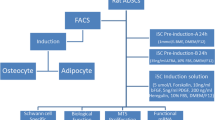Abstract
Objective
To investigate the effect of dihydrotestosterone (DHT) combined with Dezawa’s method on the differentiation of bone marrow stromal cells (BMSCs) into schwann-like cells.
Results
Compared to the Dezawa’s method, schwann-like cells obtained from our modified method were longer and thinner and exhibited a typical bipolar or tripolar shape. These cells had a higher mRNA expression of S100 and myelin protein zero (P0), about 1.7- and 2.5-fold respectively, while the glial fibrillary acidic protein (GFAP) mRNA level was decreased about 92 %. No significant difference in peripheral myelin protein 22 (PMP22) mRNA expression was found. Immunofluorescence and Western blot showed the similar results.
Conclusion
DHT in combination with Dezawa’s method to induce a BMSCs to differentiate into schwann-like cells with higher expression of P0, which might be more effective in clinical application than previous method for nerve regeneration.




Similar content being viewed by others
References
Bronstein JM (2000) Function of tetraspan proteins in the myelin sheath. Curr Opin Neurobiol 10:552–557
Desarnaud F, Do TA, Brown AM et al (1998) Progesterone stimulates the activity of the promoters of peripheral myelin protein-22 and protein zero genes in schwann cell. J Neurochem 71:1765–1768
Dezawa M, Takahashi I, Esaki M et al (2001) Sciatic nerve regeneration in rats induced by transplantation of in vitro differentiated bone-marrow stromal cells. Eur J Neurosci 14:1771–1776
D’Urso D, Ehrhardt P, Muller HW (1999) Peripheral myelin protein 22 and protein zero: a novel association in peripheral nervous system myelin. J Neurosci 19:3396–3403
Hou SY, Zhang HY, Quan DP et al (2006) Tissue-engineered peripheral nerve grafting by differentiated bone marrow stromal cells. Neuroscience 140:101–110
Hussain R, Ghoumari AM, Bielecki B et al (2013) The neural androgen receptor: a therapeutic target for myelin repair in chronic demyelination. Brain 136:132–146
Kaewkhaw R, Scutt AM, Haycock JW (2011) Anatomical site influences the differentiation of adipose-derived stem cells for Schwann-cell phenotype and function. Glia 59:734–749
Liu Y, Chen J, Liu W et al (2016) A modified approach to inducing bone marrow stromal cells to differentiate into cells with mature schwann cell phenotypes. Stem Cell Develop 25:347–359
Magnaghi V, Cavarretta I, Zucchi I et al (1999) Po gene expression is modulated by androgens in the sciatic nerve of adult male rats. Brain Res Mol Brain Res 70:36–44
Mantovani C, Mahay D, Kingham M et al (2010) Bone marrow- and adipose-derived stem cells show expression of myelin mRNAs and proteins. Regen Med 5:403–410
Melcangi RC, Cavarretta IT, Ballabio M et al (2005) Peripheral nerves: a target for the action of neuroactive steroids. Brain Res Brain Res Rev 48:328–338
Melcangi RC, Giatti S, Pesaresi M et al (2011) Role of neuroactive steroids in the peripheral nervous system. Front Endocrinol 2:104
Movaghar B, Tiraihi T, Mesbah-Namin SA (2008) Transdifferentiation of bone marrow stromal cells into Schwann cell phenotype using progesterone as inducer. Brain Res 1208:17–24
Park HW, Lim MJ, Jung H et al (2010) Human mesenchymal stem cell-derived Schwann cell-like cells exhibit neurotrophic effects, via distinct growth factor production, in a model of spinal cord injury. Glia 58:1118–1132
Wiberg M, Terenghi G (2003) Will it be possible to produce peripheral nerves? Surg Technol Int 11:303–310
Acknowledgments
This work was supported by the National Natural Science Foundation of China (Grant Number: 81471270).
Supporting information
Supplementary Table 1—Sequences of qRT-PCR primers.
Author information
Authors and Affiliations
Corresponding author
Ethics declarations
Conflict of interest
The authors declare that they have no conflict of interest.
Electronic supplementary material
Below is the link to the electronic supplementary material.
Rights and permissions
About this article
Cite this article
Yang, X., Chen, J., Xue, P. et al. Differentiation of bone marrow stromal cells into schwann-like cells using dihydrotestosterone combined with a classical induction method. Biotechnol Lett 39, 331–337 (2017). https://doi.org/10.1007/s10529-016-2239-4
Received:
Accepted:
Published:
Issue Date:
DOI: https://doi.org/10.1007/s10529-016-2239-4



